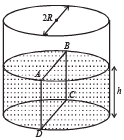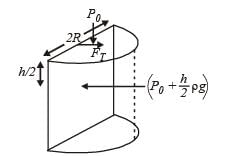JEE Exam > JEE Questions > Water is filled up to a height h in a beaker ...
Start Learning for Free
Water is filled up to a height h in a beaker of radius R as shown in the figure. The density of water is r, the surface tension of water is T and the atmospheric pressure is P0.
Consider a vertical section ABCD of the water column through a diameter of the beaker. The force on water on one side of this section by water on the other side of this section has magnitude
Consider a vertical section ABCD of the water column through a diameter of the beaker. The force on water on one side of this section by water on the other side of this section has magnitude

- a)

- b)

- c)

- d)

Correct answer is option 'B'. Can you explain this answer?
Verified Answer
Water is filled up to a height h in a beaker of radius R as shown in t...


Note : In the first part the force is created due to pressure and in the second part the force is due to surface tension T.
∴ Force = 2P0Rh + Rrgh2 – 2RT

|
Explore Courses for JEE exam
|

|
Similar JEE Doubts
Water is filled up to a height h in a beaker of radius R as shown in the figure. The density of water is r, the surface tension of water is T and the atmospheric pressure is P0.Consider a vertical section ABCD of the water columnthrough a diameter of the beaker. The force on water on one side of this section by water on the other side of this section has magnitudea)b)c)d)Correct answer is option 'B'. Can you explain this answer?
Question Description
Water is filled up to a height h in a beaker of radius R as shown in the figure. The density of water is r, the surface tension of water is T and the atmospheric pressure is P0.Consider a vertical section ABCD of the water columnthrough a diameter of the beaker. The force on water on one side of this section by water on the other side of this section has magnitudea)b)c)d)Correct answer is option 'B'. Can you explain this answer? for JEE 2025 is part of JEE preparation. The Question and answers have been prepared according to the JEE exam syllabus. Information about Water is filled up to a height h in a beaker of radius R as shown in the figure. The density of water is r, the surface tension of water is T and the atmospheric pressure is P0.Consider a vertical section ABCD of the water columnthrough a diameter of the beaker. The force on water on one side of this section by water on the other side of this section has magnitudea)b)c)d)Correct answer is option 'B'. Can you explain this answer? covers all topics & solutions for JEE 2025 Exam. Find important definitions, questions, meanings, examples, exercises and tests below for Water is filled up to a height h in a beaker of radius R as shown in the figure. The density of water is r, the surface tension of water is T and the atmospheric pressure is P0.Consider a vertical section ABCD of the water columnthrough a diameter of the beaker. The force on water on one side of this section by water on the other side of this section has magnitudea)b)c)d)Correct answer is option 'B'. Can you explain this answer?.
Water is filled up to a height h in a beaker of radius R as shown in the figure. The density of water is r, the surface tension of water is T and the atmospheric pressure is P0.Consider a vertical section ABCD of the water columnthrough a diameter of the beaker. The force on water on one side of this section by water on the other side of this section has magnitudea)b)c)d)Correct answer is option 'B'. Can you explain this answer? for JEE 2025 is part of JEE preparation. The Question and answers have been prepared according to the JEE exam syllabus. Information about Water is filled up to a height h in a beaker of radius R as shown in the figure. The density of water is r, the surface tension of water is T and the atmospheric pressure is P0.Consider a vertical section ABCD of the water columnthrough a diameter of the beaker. The force on water on one side of this section by water on the other side of this section has magnitudea)b)c)d)Correct answer is option 'B'. Can you explain this answer? covers all topics & solutions for JEE 2025 Exam. Find important definitions, questions, meanings, examples, exercises and tests below for Water is filled up to a height h in a beaker of radius R as shown in the figure. The density of water is r, the surface tension of water is T and the atmospheric pressure is P0.Consider a vertical section ABCD of the water columnthrough a diameter of the beaker. The force on water on one side of this section by water on the other side of this section has magnitudea)b)c)d)Correct answer is option 'B'. Can you explain this answer?.
Solutions for Water is filled up to a height h in a beaker of radius R as shown in the figure. The density of water is r, the surface tension of water is T and the atmospheric pressure is P0.Consider a vertical section ABCD of the water columnthrough a diameter of the beaker. The force on water on one side of this section by water on the other side of this section has magnitudea)b)c)d)Correct answer is option 'B'. Can you explain this answer? in English & in Hindi are available as part of our courses for JEE.
Download more important topics, notes, lectures and mock test series for JEE Exam by signing up for free.
Here you can find the meaning of Water is filled up to a height h in a beaker of radius R as shown in the figure. The density of water is r, the surface tension of water is T and the atmospheric pressure is P0.Consider a vertical section ABCD of the water columnthrough a diameter of the beaker. The force on water on one side of this section by water on the other side of this section has magnitudea)b)c)d)Correct answer is option 'B'. Can you explain this answer? defined & explained in the simplest way possible. Besides giving the explanation of
Water is filled up to a height h in a beaker of radius R as shown in the figure. The density of water is r, the surface tension of water is T and the atmospheric pressure is P0.Consider a vertical section ABCD of the water columnthrough a diameter of the beaker. The force on water on one side of this section by water on the other side of this section has magnitudea)b)c)d)Correct answer is option 'B'. Can you explain this answer?, a detailed solution for Water is filled up to a height h in a beaker of radius R as shown in the figure. The density of water is r, the surface tension of water is T and the atmospheric pressure is P0.Consider a vertical section ABCD of the water columnthrough a diameter of the beaker. The force on water on one side of this section by water on the other side of this section has magnitudea)b)c)d)Correct answer is option 'B'. Can you explain this answer? has been provided alongside types of Water is filled up to a height h in a beaker of radius R as shown in the figure. The density of water is r, the surface tension of water is T and the atmospheric pressure is P0.Consider a vertical section ABCD of the water columnthrough a diameter of the beaker. The force on water on one side of this section by water on the other side of this section has magnitudea)b)c)d)Correct answer is option 'B'. Can you explain this answer? theory, EduRev gives you an
ample number of questions to practice Water is filled up to a height h in a beaker of radius R as shown in the figure. The density of water is r, the surface tension of water is T and the atmospheric pressure is P0.Consider a vertical section ABCD of the water columnthrough a diameter of the beaker. The force on water on one side of this section by water on the other side of this section has magnitudea)b)c)d)Correct answer is option 'B'. Can you explain this answer? tests, examples and also practice JEE tests.

|
Explore Courses for JEE exam
|

|
Signup for Free!
Signup to see your scores go up within 7 days! Learn & Practice with 1000+ FREE Notes, Videos & Tests.
























